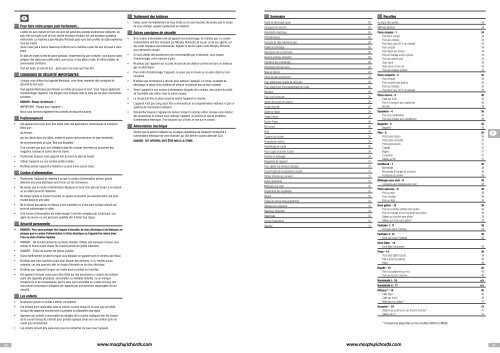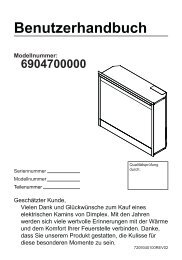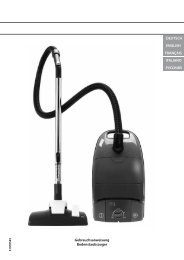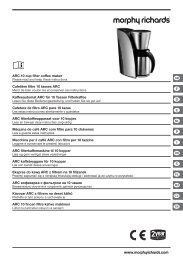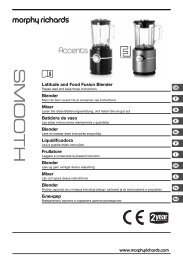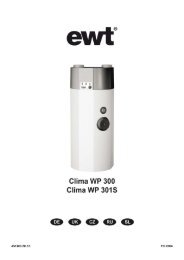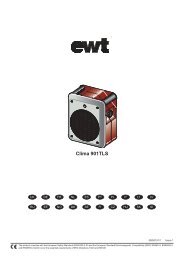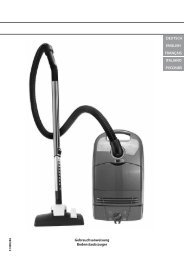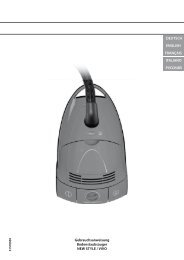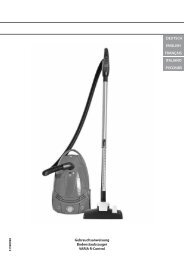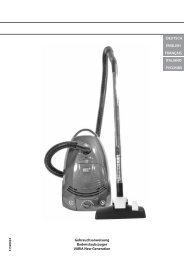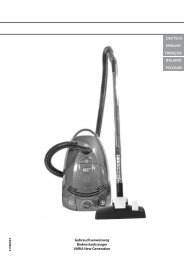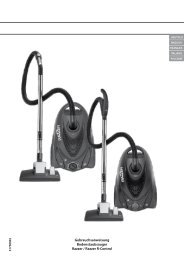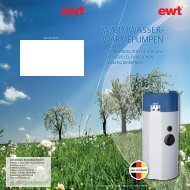9094 48960MEE Multitool ib ml - EWT
9094 48960MEE Multitool ib ml - EWT
9094 48960MEE Multitool ib ml - EWT
Create successful ePaper yourself
Turn your PDF publications into a flip-book with our unique Google optimized e-Paper software.
Ingredient Temperatures<br />
All ingredients, including the machine and pan, and especially liquids (water or milk),<br />
should be warmed to room temperature 21°C (70°F). If ingredients are too cold, below<br />
10°C (50°F), they will not activate the yeast. Extremely hot liquids, above 40°C (104°F),<br />
may kill the yeast.<br />
Glazing<br />
Give your just baked bread a professional finish. Select one of the following special glazes<br />
to enhance your bread.<br />
Egg glaze<br />
Beat 1 large egg and 1 tablespoon of water together, brush generously.<br />
Note: this glaze is only for bread where the dough has been prepared in the breadmaker<br />
and is then being baked in the oven. The glaze should be applied when the dough is<br />
removed from the breadmaker. Do not apply this glaze to doughs in the breadmaker.<br />
Melted butter crust<br />
Brush melted butter over just baked bread for a softer, tender crust.<br />
Milk glaze<br />
For a softer, shiny crust, brush just baked bread with milk or cream.<br />
Sweet icing glaze<br />
Mix 1 cup sifted icing sugar with 1 to 2 tablespoons of milk to make a glaze consistency<br />
and drizzle over raisin bread or sweet breads.<br />
Poppy/Sesame/Caraway seed/Oatmeal<br />
Sprinkle your choice of these seeds generously over just glazed bread.<br />
Conversion Chart<br />
Liquids, flour and others<br />
We recommend that you use the cup provided for all recipes for consistency between<br />
brands and types of flour.<br />
The cup provided is based on the American cup measurement of 8 Floz.<br />
For people who prefer to use their own measuring utensils, alternative measurements are in<br />
millilitres (<strong>ml</strong>) and cubic centimetres (cc) for liquid measurement and grams (gm) for<br />
weight of flour, sugar and fruit.<br />
Note: A good quality set of accurate kitchen scales with divisions and accuracy to 2 grams<br />
are required.<br />
A measuring jug with divisions of 2 <strong>ml</strong> is required.<br />
The tablespoon and teaspoon provided are required to measure the smaller quantities.<br />
A set of British standard spoons with ‘scrape’ level tops can be used.<br />
Do not use a kitchen tablespoon or teaspoon as they are inaccurate.<br />
F.A.Q.<br />
Questions about general performance and operation.<br />
Question 1<br />
What should I do if the kneading blade comes out with the bread/<br />
Remove it with a pair of plastic tongs before slicing the bread. Since the blade can be<br />
disconnected from the pan, it is not a malfunction if it comes out in your bread.<br />
Question 2<br />
Why does my bread sometimes have some flour on the side crust?<br />
In some cases, the flour mix may remain on the corners of the baking pan. When this<br />
happens, it usually can be eaten or simply trim off that portion of the outer crust with a<br />
sharp knife.<br />
Question 3<br />
Why isn't the dough mixing? I can hear the motor running.<br />
The Kneading Blade or baking pan may not be inserted properly. Make sure the pan is<br />
facing the right way and that it has ‘clicked’ and seated into the bottom of the breadmaker.<br />
Question 4<br />
How long does it take to make bread?<br />
Timings for each setting are outlined earlier.<br />
Question 5<br />
Why can't I use the timer when baking with fresh milk?<br />
The milk will spoil if left sitting in the machine too long. Fresh ingredients such as eggs and<br />
milk should never be used with the delayed timer feature.<br />
Question 6<br />
Why do I have to add the ingredients in a certain order?<br />
This allows the breadmaker to mix the ingredients in the most efficient manner poss<strong>ib</strong>le. It<br />
also serves to keep the yeast from combining with the liquid before the dough has started<br />
to mix, which is essential on the time delay.<br />
Question 7<br />
When setting the timer for morning, why does the machine make sounds late at night?<br />
The machine must start operation when the time delay reaches the start time of the<br />
programme so that the bread will be ready. These sounds are made by the motor when<br />
kneading the dough. It is a normal operation, not a malfunction.<br />
Question 8<br />
The kneading blade is stuck in the bread pan. After baking how do I get it out?<br />
The kneading blade may ‘stick’ in place after baking. Running warm or hot water over the<br />
blade should loosen it enough to be removed. If still stuck, soak in hot water for about 30<br />
minutes.<br />
Question 9<br />
Can I wash the baking pan in the dishwasher?<br />
No. The baking pan and kneading blade must be washed by hand.<br />
Question 10<br />
What will happen if I leave the finished bread in the baking pan?<br />
Whilst still in the breadmaker for the first hour after baking is complete the bread ‘keeps<br />
warm’ to prevent it becoming ‘soggy’. Leaving the bread in the breadmaker after the keep<br />
warm period may result in a ‘soggy’ loaf of bread as excess steam (moisture) would not be<br />
able to escape. Remove and allow to cool on a wire rack after baking to prevent this.<br />
Question 11<br />
Why did the dough only partially mix? Why didn't it mix completely?<br />
The dough may be too heavy or dry. Also, the kneading blade or baking pan may not be<br />
inserted properly. Ingredients may have been added in the wrong order.<br />
Question 12<br />
Why didn't the bread rise?<br />
The yeast could be bad, past it’s sell by date or poss<strong>ib</strong>ly no yeast was added at all. Also, if<br />
the mixing was not complete, rising problems could develop.<br />
Question 13<br />
What is the minimum and maximum time a cycle may be delayed?<br />
The maximum length of delay is 13 hours including the total cycle time. For example,<br />
Setting 1 (basic small) has a cycle time of 3:20. This start is delayed by a maximum of<br />
9:40. The minimum length of delay for each setting is 10 minutes. The delay clock<br />
increases and decreases in increments of 10 minutes.<br />
Question 14<br />
How do I know when to add raisins, nuts, etc. to the bread?*<br />
There is a beeper tone to signal that you may add raisins, nuts, etc. during the second<br />
kneading cycle.<br />
Note: See ‘Baking cycle times’ chart for ‘Add nuts & raisins’ time.<br />
* Only applicable to model 48321 without fruit & nut dispenser.<br />
In some cases, ingredients can be broken up during the initial kneading cycle. Each recipe<br />
indicates the best time to add fruit and nuts to the dough.<br />
Question 15<br />
Why does my bread comes out too moist? What can I do?<br />
Humidity may affect the dough. Add an extra tablespoon of flour. Also, high altitude may<br />
have the same effect. Decrease the amount of yeast by ¼ teaspoon and decrease the sugar<br />
and/or water/milk slightly.<br />
Question 16<br />
Why do I get air bubbles at the top of the bread?<br />
This can be caused by using too much yeast. Decrease the yeast by ¼ tsp.<br />
Question 17<br />
Why does my bread rise and then collapse or crater?<br />
The bread may be rising too much. To reduce the rate of rising, reduce the amount of yeast<br />
and/or increase the amount of salt.<br />
Question 18<br />
Can I use my favourite bread recipes (traditional yeast bread) in my bread machine?<br />
Yes, but you will need to experiment to get the right proportion of ingredients. Become<br />
familiar with the unit and make several loaves of bread before you begin experimenting.<br />
Never exceed a total amount of 5 cups dry ingredients (that includes the total amount of<br />
flour, oats, oatmeal, bran). Use the recipes in this book to help determine the ratio of dry<br />
ingredients to liquid and amounts of yeast, sugar, salt, and oil/butter/margarine to use.<br />
We advise creating your own bread recipes using the basic mode, then progress to the<br />
others, using the Baking cycle times chart as a guide.<br />
Question 19<br />
Is it important for ingredients to be at room temperature before adding them to the<br />
baking pan?<br />
Yes, even when the delay timer is being used. (Water must be between 21°C and 28°C).<br />
Question 20<br />
Why do the loaves vary in height and weight? The whole wheat/wholewheat breads are<br />
always shorter. Am I doing something wrong?<br />
No, it is normal for wholewheat and wholemeal breads to be shorter and denser than basic<br />
or French breads. Wholewheat and wholemeal flour are heavier than white bread flour,<br />
therefore they don’t rise as much during the bread baking process. This is also true for<br />
bread containing fruit, nuts, oats and bran.<br />
Question 21<br />
Can I premix the yeast with water?<br />
No, the yeast must be kept dry and put into the baking pan last, above the flour. This is<br />
especially important when the delay timer is being used.<br />
Question 22<br />
Why is there a large hole in the base of the bread?<br />
This hole has been created by the kneading blade. Sometimes this hole is larger than<br />
normal. This is because the dough has rested to the side of the blade after the second<br />
kneading cycle - normal with bread makers. You could position the dough evenly in the<br />
base of the pan.<br />
TROUBLE SHOOTING<br />
Bread Sinks in the centre<br />
Too much liquid or liquid too warm.<br />
Measure ingredients accurately. Use liquids at temperatures between 21°C and 28°C.<br />
Salt was not added, causing bread to over rise and collapse.<br />
Measure ingredients accurately.<br />
Too much yeast was added Measure ingredients accurately, if problem persists, reduce<br />
yeast by ¼ teaspoon.<br />
High humidity and hot ambient temperatures can cause bread to over rise and collapse.<br />
Bake during the coolest part of the day, Try reducing the yeast by ¼ teaspoon or use liquids<br />
direct from the refrigerator. Do not use the timer function.<br />
High altitudes can cause the bread to over rise and then collapse during baking.<br />
Try reducing the yeast by ¼ teaspoon.<br />
Lid is open during baking.<br />
Do not open the lid during baking.<br />
Bread did not rise enough<br />
Not enough yeast was added. Measure ingredients accurately.<br />
Yeast is outdated or inactive.<br />
Never use outdated yeast. Store in a cool, dark place.<br />
Too little sugar was added.<br />
Measure ingredients accurately.<br />
Too much salt was added, reducing the action of the yeast.<br />
Measure ingredients accurately.<br />
Water was too hot and killed the yeast.<br />
Use liquids at temperatures between 21°C and 28°C<br />
Yeast has been activated before programme has started.<br />
Take care that yeast does not come in contact with liquid before programme has started.<br />
Bread rises too much<br />
High humidity and hot ambient temperatures can cause bread to over rise.<br />
Bake during the coolest part of the day. Try reducing the yeast by ¼ teaspoon or use liquids<br />
directly from the refrigerator. Do not use the Timer function.<br />
Too much yeast.<br />
Measure ingredients accurately.<br />
Too much liquid.<br />
Measure ingredients accurately.<br />
Hot liquids accelerated the yeast action.<br />
Use liquids at temperatures between 21°C and 28°C.<br />
Too much flour or not enough salt.<br />
Measure ingredients accurately.<br />
Bread dry with dense texture<br />
Not enough liquid added.<br />
Measure ingredients accurately.<br />
Flour may be passed the use by date, or be dry causing wet/dry imbalance.<br />
Try increasing liquid by 1 tbsp at a time.<br />
Bread under baked with soggy centre<br />
Too much liquid from fresh or canned fruit.<br />
Always drain liquids well as specified in the recipe. Water may have to be reduced<br />
slightly.<br />
Large amounts of rich ingredients like nuts, butter, dried fruits, syrups and grains will<br />
make dough heavy. This will slow down the rising and prevent the bread from baking<br />
through.<br />
Measure ingredients accurately. Never exceed the amounts in the recipe.<br />
Bread over browned<br />
Too much sugar.<br />
Measure ingredients accurately.<br />
Crust colour set too high.<br />
Set crust colour to a lighter setting.<br />
Bread has large holes in texture<br />
Water was too hot and killed the yeast.<br />
Use liquids at temperatures between 21°C and 28°C<br />
Too much liquid.<br />
Measure ingredients accurately.<br />
Too much yeast.<br />
Measure ingredients accurately.<br />
High humidity and hot ambient temperatures increase yeast activity.<br />
Bake during the coolest part of the day. Try reducing the yeast by ¼ teaspoon or use liquids<br />
direct from the refrigerator.<br />
Do not use the timer function.<br />
Water was too hot and killed the yeast.<br />
Use liquids at temperatures between 21°C and 28°C.<br />
Bread surface is sticky<br />
Bread was left in the machine too long and condensation collected on the baking pan.<br />
Whenever poss<strong>ib</strong>le, remove bread from the baking pan and cool on a wire rack before keep<br />
warm period ends.<br />
The wet/dry balance of the ingredients may be incorrect. Measure ingredients accurately.<br />
H:HH Message on display<br />
Temperature in breadmaker is too high.<br />
Press the Stop button. Remove the baking pan, leave lid open and allow to cool. When<br />
cool, put the baking pan back in, set programme and start the programme again.<br />
E:EE Message on display<br />
Temperature sensor is disconnected. Refer to Morphy Richards Helpline or local distr<strong>ib</strong>utor.<br />
Difficult to remove bread from the pan<br />
The bread is sticking to the pan.<br />
The surface of the pan needs to be oiled before everyday use. Wash the pan in hot soapy<br />
water and thoroughly dry. L<strong>ib</strong>erally coat the inner surface of the pan with oil,<br />
butter or margarine. Follow the guide, ‘Using your breadmaker’. When the bread pan is<br />
removed from the machine after the baking programme allow the bread to cool in the pan<br />
for 15 minutes before turning out onto a rack. Only slice the bread when fully cooled after<br />
20-40 minutes.<br />
Condensation in the Fruit and Nut dispenser<br />
Please note that if your machine has a fruit & nut dispenser, during the baking process,<br />
condensation will form on the inside of the dispenser. This is totally normal and does not<br />
affect the quality of the bread.<br />
RECIPES<br />
The recipes in this booklet have been thoroughly tested to ensure best results. Recipes<br />
have been created by home economists specifically for this machine and may not produce<br />
acceptable results in other similar machines.<br />
• Always add ingredients in the order they are listed in the recipe.<br />
• Accurate measuring of ingredients is vital. Do not use larger amounts<br />
• All of the following recipes use this same general method:<br />
1 Measure ingredients into baking pan.<br />
2 Use tepid water 21-28°C.<br />
3 Insert baking pan securely into unit, close lid.<br />
4 Select appropriate bread setting.<br />
5 Push start button.<br />
6 When bread is done, remove pan from unit using oven mitts.<br />
7 Remove bread from baking pan, (and kneading blade from bread if necessary).<br />
8 Allow to cool before slicing.<br />
This method is modified by notes, if applicable, at the end of each recipe. These recipes<br />
have been developed using leading brands of flour and fast action yeast.<br />
RECIPES FOR BASIC BREAD (1)<br />
Basic white bread<br />
1 lb 1½ lb 2 lb<br />
Water ¾ cup 1¹⁄8 cup 1½ cup<br />
Skimmed milk powder** 2 tbsp 2½ tbsp 4 tbsp<br />
Sunflower oil 2 tbsp 2½ tbsp 4 tbsp<br />
Sugar 1¼ tbsp 2¼ tbsp 3 tbsp<br />
Salt 1 tsp 1¼ tsp 2 tsp<br />
Strong white bread flour 2 cup 3 cup 4 cup<br />
Fast action yeast 1 tsp 1¼ tsp 1¼ tsp<br />
Use setting 1 Basic<br />
Soft grain bread<br />
1½ lb 2 lb<br />
Water 1¹⁄8 cup 1½ cup<br />
Skimmed milk powder** 2½ tbsp 4 tbsp<br />
Sunflower oil 2 tbsp 2½ tbsp<br />
Sugar 2¼ tbsp 3 tbsp<br />
Salt 1¼ tsp 2 tsp<br />
Strong white soft grain bread flour 3 cup 4 cup<br />
Fast action yeast 1 tsp 1 tsp<br />
Use setting 1 Basic<br />
**If skimmed milk not available, it can be omitted (from the recipe).<br />
14 15<br />
g


